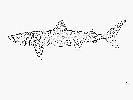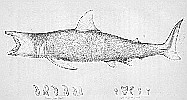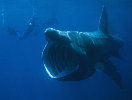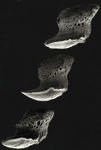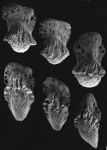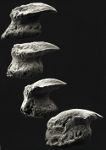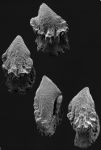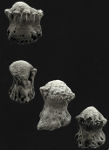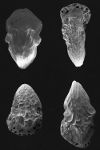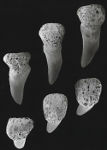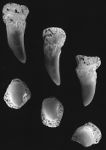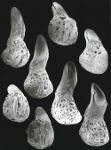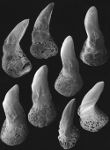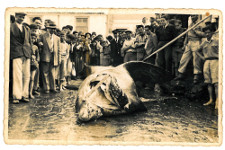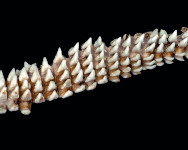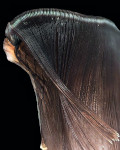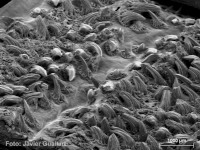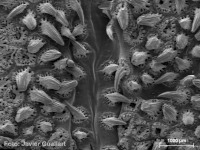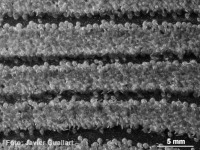Cetorhinus maximus
(Gunnerus, 1765)
Basking shark
Classification: Elasmobranchii Lamniformes Cetorhinidae
Reference of the original description
Brugden (Squalus maximus), Beskrvenen ved J. E. Gunnerus. Det Trondhiemske Selskabs Skrifter, 3: 33–49, pl. 2
Brugden (Squalus maximus), Beskrvenen ved J. E. Gunnerus. Det Trondhiemske Selskabs Skrifter, 3: 33–49, pl. 2
Image of the original description
.jpg)
Cetorhinus maximus (Gunnerus, 1765)
.jpg)
Cetorhinus maximus (Gunnerus, 1765)
Synonyms / new combinations and misspellings
Carcharodon selachoides, Cetorhinus aff. maximus, Cetorhinus auratus, Cetorhinus blainvillei, Cetorhinus cf. maximus, Cetorhinus duponti, Cetorhinus maccoyi, Cetorhinus maximus infanuncula, Cetorhinus maximus normani , Cetorhinus normani, Cetorhinus rostratus, Cetorhinus (Selache) maximus, Halsydrus maccoyi, Halsydrus maximus, Halsydrus maximus maccoyi, Halsydrus mccoyi, Halsydrus pontoppidani, Hannoveria aurata, Polyprosopus macer, Selache aurata, Selache duponti, Selache maxima, Selache maximus, Selache (Hannoveria) aurata, Selachus maximus, Selachus pennantii, Squalus cetaceus, Squalus elephas, Squalus gunneri, Squalus gunnerianus, Squalus homianus, Squalus isodus, Squalus maximus, Squalus pelegrinus, Squalus peregrinus, Squalus rashleighanus, Squalus rhinoceros, Squalus rostratus, Squalus (Cetorhinus) gunneri, Squalus (Cetorhinus) shavianus, Squalus (Selache) maximus, Tetroras angiova, Tetroras maccoyi
Carcharodon selachoides, Cetorhinus aff. maximus, Cetorhinus auratus, Cetorhinus blainvillei, Cetorhinus cf. maximus, Cetorhinus duponti, Cetorhinus maccoyi, Cetorhinus maximus infanuncula, Cetorhinus maximus normani , Cetorhinus normani, Cetorhinus rostratus, Cetorhinus (Selache) maximus, Halsydrus maccoyi, Halsydrus maximus, Halsydrus maximus maccoyi, Halsydrus mccoyi, Halsydrus pontoppidani, Hannoveria aurata, Polyprosopus macer, Selache aurata, Selache duponti, Selache maxima, Selache maximus, Selache (Hannoveria) aurata, Selachus maximus, Selachus pennantii, Squalus cetaceus, Squalus elephas, Squalus gunneri, Squalus gunnerianus, Squalus homianus, Squalus isodus, Squalus maximus, Squalus pelegrinus, Squalus peregrinus, Squalus rashleighanus, Squalus rhinoceros, Squalus rostratus, Squalus (Cetorhinus) gunneri, Squalus (Cetorhinus) shavianus, Squalus (Selache) maximus, Tetroras angiova, Tetroras maccoyi
Types
Cetorhinus maximus
XXXX: No types known;
Cetorhinus blainvillei
XXXX: No types known;
Cetorhinus normani
Syntype: MACN: ?
Halsydrus mccoyi
XXXX: No types known;
Squalus cetaceus
XXXX: No types known;
Squalus gunnerianus
XXXX: No types known;
Squalus homianus
XXXX: No types known;
Squalus isodus
XXXX: No types known;
Squalus pelegrinus
Holotype: MNHN: 9853;
Squalus rashleighanus
XXXX: No types known;
Squalus rhinoceros
XXXX: No types known;
Squalus rostratus
XXXX: No types known;
Tetroras angiova
XXXX: No types known;
Tetroras maccoyi
XXXX: No types known;
Cetorhinus maximus
XXXX: No types known;
Cetorhinus blainvillei
XXXX: No types known;
Cetorhinus normani
Syntype: MACN: ?
Halsydrus mccoyi
XXXX: No types known;
Squalus cetaceus
XXXX: No types known;
Squalus gunnerianus
XXXX: No types known;
Squalus homianus
XXXX: No types known;
Squalus isodus
XXXX: No types known;
Squalus pelegrinus
Holotype: MNHN: 9853;
Squalus rashleighanus
XXXX: No types known;
Squalus rhinoceros
XXXX: No types known;
Squalus rostratus
XXXX: No types known;
Tetroras angiova
XXXX: No types known;
Tetroras maccoyi
XXXX: No types known;
Description :
Citation: Cetorhinus maximus (Gunnerus, 1765): In: Database of modern sharks, rays and chimaeras, www.shark-references.com, World Wide Web electronic publication, Version 12/2024
Please send your images of "Cetorhinus maximus" to info@shark-references.com
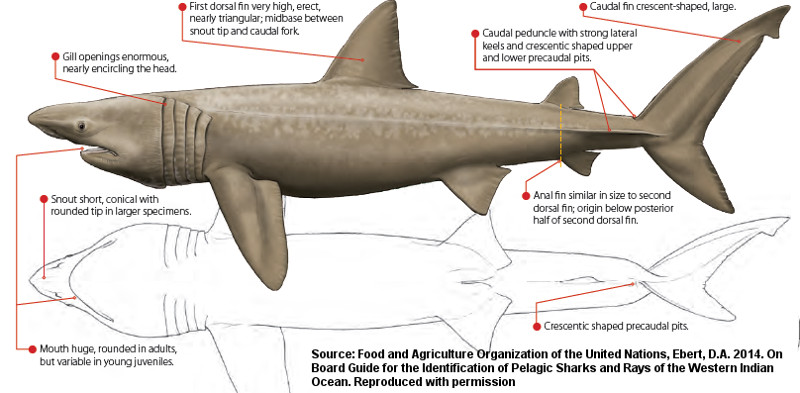
Cetorhinus maximus (Gunnerus, 1765), © FAO, Food and Agriculture Organization of the United Nations, Ebert, D.A. 2014. On Board Guide for the Identification of Pelagic Sharks and Rays of the Western Indian Ocean. Reproduced with permission, illustration by Marc Dando , Wildlife Illustrator

Cetorhinus maximus (Gunnerus, 1765), © FAO, Food and Agriculture Organization of the United Nations, Ebert, D.A. 2014. On Board Guide for the Identification of Pelagic Sharks and Rays of the Western Indian Ocean. Reproduced with permission, illustration by Marc Dando , Wildlife Illustrator
Common names
 Mandelhai,
Mandelhai,  Riesenhai,
Riesenhai,  Colayo,
Colayo,  Marrajo ballenato,
Marrajo ballenato,  Marrajo gigante,
Marrajo gigante,  Peje vaca,
Peje vaca,  Peregrino,
Peregrino,  Pez elefante,
Pez elefante,  Tiburón canasta,
Tiburón canasta,  Tiburón peregrino,
Tiburón peregrino,  Poisson à voiles,
Poisson à voiles,  Pèlerin,
Pèlerin,  Requin,
Requin,  Requin pèlerin,
Requin pèlerin,  Squale géant,
Squale géant,  Squale pèlerin,
Squale pèlerin,  Éléphant de mer,
Éléphant de mer,  Basking shark,
Basking shark,  Basking tresher,
Basking tresher,  Bone shark,
Bone shark,  Elephant shark,
Elephant shark,  Hoe-mother,
Hoe-mother,  Shark,
Shark,  Sun-fish,
Sun-fish,  Sunfish,
Sunfish,  Cagna,
Cagna,  Can,
Can,  Canisca,
Canisca,  Imbestino,
Imbestino,  Mmistinu,
Mmistinu,  Pesce elefante,
Pesce elefante,  Pesce pappagallo,
Pesce pappagallo,  Pisci sceccu,
Pisci sceccu,  Squalo elefante,
Squalo elefante,  Squalo gigante,
Squalo gigante,  Squalo pellegrino,
Squalo pellegrino,  Squalo rostrato,
Squalo rostrato,  Albafar,
Albafar,  Cação-peregrino-argentino,
Cação-peregrino-argentino,  Frade,
Frade,  Peixe frade,
Peixe frade,  Peixe-carago,
Peixe-carago,  Peixe-frade,
Peixe-frade,  Peregrino,
Peregrino,  Relengueiro,
Relengueiro,  Tubarâo-frade,
Tubarâo-frade,  Tubarão frade,
Tubarão frade,  Tubarão-peregrino, Gabdoll (malta)
Tubarão-peregrino, Gabdoll (malta)
 Mandelhai,
Mandelhai,  Riesenhai,
Riesenhai,  Colayo,
Colayo,  Marrajo ballenato,
Marrajo ballenato,  Marrajo gigante,
Marrajo gigante,  Peje vaca,
Peje vaca,  Peregrino,
Peregrino,  Pez elefante,
Pez elefante,  Tiburón canasta,
Tiburón canasta,  Tiburón peregrino,
Tiburón peregrino,  Poisson à voiles,
Poisson à voiles,  Pèlerin,
Pèlerin,  Requin,
Requin,  Requin pèlerin,
Requin pèlerin,  Squale géant,
Squale géant,  Squale pèlerin,
Squale pèlerin,  Éléphant de mer,
Éléphant de mer,  Basking shark,
Basking shark,  Basking tresher,
Basking tresher,  Bone shark,
Bone shark,  Elephant shark,
Elephant shark,  Hoe-mother,
Hoe-mother,  Shark,
Shark,  Sun-fish,
Sun-fish,  Sunfish,
Sunfish,  Cagna,
Cagna,  Can,
Can,  Canisca,
Canisca,  Imbestino,
Imbestino,  Mmistinu,
Mmistinu,  Pesce elefante,
Pesce elefante,  Pesce pappagallo,
Pesce pappagallo,  Pisci sceccu,
Pisci sceccu,  Squalo elefante,
Squalo elefante,  Squalo gigante,
Squalo gigante,  Squalo pellegrino,
Squalo pellegrino,  Squalo rostrato,
Squalo rostrato,  Albafar,
Albafar,  Cação-peregrino-argentino,
Cação-peregrino-argentino,  Frade,
Frade,  Peixe frade,
Peixe frade,  Peixe-carago,
Peixe-carago,  Peixe-frade,
Peixe-frade,  Peregrino,
Peregrino,  Relengueiro,
Relengueiro,  Tubarâo-frade,
Tubarâo-frade,  Tubarão frade,
Tubarão frade,  Tubarão-peregrino, Gabdoll (malta)
Tubarão-peregrino, Gabdoll (malta)
Short Description
Distinguished from all other sharks by the enormous gill slits practically encircling the head; dermal denticle gill rakers; pointed snout; huge, sub terminal mouth with minute hooked teeth; caudal peduncle with strong lateral keels, and lunate caudal fin. Body covered with placoid scales. (Other sources of morphological data: Ref. 309, 5983).
Distinguished from all other sharks by the enormous gill slits practically encircling the head; dermal denticle gill rakers; pointed snout; huge, sub terminal mouth with minute hooked teeth; caudal peduncle with strong lateral keels, and lunate caudal fin. Body covered with placoid scales. (Other sources of morphological data: Ref. 309, 5983).
Distribution
Cosmopolitan. Western Atlantic: Newfoundland, Canada to Florida, USA; southern Brazil to Argentina. Eastern Atlantic: Iceland, Norway and western Barents Sea to the Mediterranean and Senegal; also western Cape Province, South Africa. Western Pacific: Japan to New Zealand. Eastern Pacific: Gulf of Alaska to Chile; possibly the Galapagos Islands. Highly migratory species, Annex I of the 1982 Convention on the Law of the Sea [20076]. At risk of extinction by overfishing because of low to very low productivity (Ref. 36717). International trade restricted (CITES Appendix II, since 28.5.2003). Source: www.gbif.org
Cosmopolitan. Western Atlantic: Newfoundland, Canada to Florida, USA; southern Brazil to Argentina. Eastern Atlantic: Iceland, Norway and western Barents Sea to the Mediterranean and Senegal; also western Cape Province, South Africa. Western Pacific: Japan to New Zealand. Eastern Pacific: Gulf of Alaska to Chile; possibly the Galapagos Islands. Highly migratory species, Annex I of the 1982 Convention on the Law of the Sea [20076]. At risk of extinction by overfishing because of low to very low productivity (Ref. 36717). International trade restricted (CITES Appendix II, since 28.5.2003). Source: www.gbif.org
Human uses
fisheries: commercial
fisheries: commercial
Biology
Exhibit ovoviparity (aplacental viviparity), with embryos feeding on other ova produced by the mother (oophagy) after the yolk sac is absorbed [733]. Gestation period probably just over one year; length at birth estimated between 1.5 and 2 m; mating thought to take place during early summer; a female giving birth to young captured in August in Norwegian waters (Ref. 5983). Distinct pairing with embrace [17086]. Often in close association with shoals of other fish such as Clupea harengus and Scomber scombrus in the Northern Atlantic [1940]. Possess long bristly gill rakers on long gill arches which facilitate filter feeding on plankton. The gill slits are correspondingly long, almost encircling the head region, and the mouth is large. Feeding is characterized by slow swimming at or near the surface, the direction of movement being erratic and without an obvious pattern. As the shark swims along the surface, its large mouth is held open for approximately 30 to 60 seconds. It periodically closes its mouth and forcefully constricts its gill arches, probably as a means to expel as much water from the buccal cavitiy [6577]. The discovery of basking sharks lacking functional gill rakers during autumn and winter in north-west European waters suggests a resting, non-feeding, demersal stage (Ref. 5967). It is suggested that hibernation in winter is possible because of the energy reserves in the large, oil-rich liver, which is lighter in spring than at the end of summer [4978].
Exhibit ovoviparity (aplacental viviparity), with embryos feeding on other ova produced by the mother (oophagy) after the yolk sac is absorbed [733]. Gestation period probably just over one year; length at birth estimated between 1.5 and 2 m; mating thought to take place during early summer; a female giving birth to young captured in August in Norwegian waters (Ref. 5983). Distinct pairing with embrace [17086]. Often in close association with shoals of other fish such as Clupea harengus and Scomber scombrus in the Northern Atlantic [1940]. Possess long bristly gill rakers on long gill arches which facilitate filter feeding on plankton. The gill slits are correspondingly long, almost encircling the head region, and the mouth is large. Feeding is characterized by slow swimming at or near the surface, the direction of movement being erratic and without an obvious pattern. As the shark swims along the surface, its large mouth is held open for approximately 30 to 60 seconds. It periodically closes its mouth and forcefully constricts its gill arches, probably as a means to expel as much water from the buccal cavitiy [6577]. The discovery of basking sharks lacking functional gill rakers during autumn and winter in north-west European waters suggests a resting, non-feeding, demersal stage (Ref. 5967). It is suggested that hibernation in winter is possible because of the energy reserves in the large, oil-rich liver, which is lighter in spring than at the end of summer [4978].
Size / Weight / Age
900 cm TL (male/unsexed; [518]); 980 cm TL (female); max. published weight: 4,000.0 kg (Ref. 4645)
900 cm TL (male/unsexed; [518]); 980 cm TL (female); max. published weight: 4,000.0 kg (Ref. 4645)
Habitat
pelagic-oceanic; oceanodromous [17660]; marine; depth range 0 - 2000 m [578], usually 0 - ? m (Ref. 55197)
pelagic-oceanic; oceanodromous [17660]; marine; depth range 0 - 2000 m [578], usually 0 - ? m (Ref. 55197)
Remarks
shark-references Species-ID=1347; CITES: (see: Protected Species for more details) Convention on International Trade in Endangered Speciesof Wild Fauna and Flora annex: II; Council Regulation 2017/160 annex: B; The neurocranium of Cetorhinus maximus (GUNNERUS, 1765) by Kunihiko Izawa and Terukazu Shibata
shark-references Species-ID=1347; CITES: (see: Protected Species for more details) Convention on International Trade in Endangered Speciesof Wild Fauna and Flora annex: II; Council Regulation 2017/160 annex: B; The neurocranium of Cetorhinus maximus (GUNNERUS, 1765) by Kunihiko Izawa and Terukazu Shibata
Parasites (arranged by Jürgen Pollerspöck)
Cestoda
Trematoda
Nematoda
Copepoda
Isopoda
Actinopterygii
- Petromyzon marinus Linnaeus, 1758 [8344]
Cestoda
- Cetorhinicola acanthocapax Beveridge & Campbell, 1988 [17838] [16112] [7398]
- Dinobothrium humile Euzet, 1952 [16311]
- Dinobothrium paciferum Sproston, 1948 [16250]
- Dinobothrium plicatum Linton, 1922 [16250]
- Dinobothrium spinosum Baylis, 1950 [16250]
- Dinobothrium spinulosum Yamaguti, 1952 [16129]
- Gastrolecithus planus (Linton, 1922) [16347] [16250] [16129] [16383] [16929]
- Reesium paciferum Sproston, 1948 [25154]
Trematoda
Nematoda
- Contracaecum plagiostomorum (Linstow, 1905) [17029]
Copepoda
- Anthosoma crassum (Abildgaard, 1794) [27825] [16609]
- Dinemoura producta (Müller, 1785) [3016] [27825] [16962] [16557] [16599] [16603] [16609]
- Lophoura edwardsi Kölliker, 1853 [16609]
- Nemesis lamna Risso, 1826 [16557] [16589] [16609]
- Nemesis lamna vermi Hewitt & Hine, 1972 [16602]
Isopoda
- Aegapheles antillensis (Schioedte & Meinert, 1879) [23898]
Actinopterygii
- Coelorinchus caelorhincus Risso, 1810 [16609]








